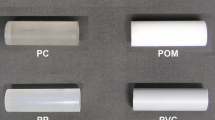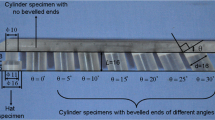Abstract
Significant errors can be present in the isothermal pressure-volume relationships that have been obtained from laterally constrained compression tests of low-strength polymeric materials. Laterally constrained compression tests on PMMA (polymethylmethacrylate) have shown these errors to result from (1) stress gradients in the specimen caused by constraint friction and (2) unknown volume changes resulting from extrusion of the test specimen. Test-specimen geometry was an important parameter.
Similar content being viewed by others
References
Murnaghan, F. D., “The Compressibility of Media under Extreme Pressures,”Proc. Natn. Acad. Sci.,30,244 (1944).
Monro, D. C., “Production and Measurement of High Pressures,”High Pressure Physics and Chemistry,1, Edited byR. S. Bradley,Academic Press,New York,11 (1963).
Stephens, D. R. andLilley, E. M., “Compressions of Isotropic Lithium Hydrides,”J. Appl. Phys.,39,177 (1968).
Warfield, R. W., “Compressibility of Bulk Polymers,”Polymer Eng. and Sci.,6,176 (1966).
Warfield, R. W., “The Compressibility of Polymers to 20,000 Atmospheres,” U. S. Naval Ordnance Laboratory Tech. Rep. 66–45 (June 1966).
Duvall, G. E., “Some Properties and Applications of Shock Waves,”in Response of Metals to High Velocity Deformation, Edited byP. G. Shewmon andV. F. Zakay, Interscience Publishers, New York, 165 (1961).
Bridgman, P. W., “Rough Compressions of 177 Substances to 40,000 kg/cm 2,”Proc. Am. Acad. Arts Sci.,76,71 (1948).
Findley, W. N., Reed, R. M. andStern, P., “Hydrostatic Creep of Plastics,”J. Appl. Mech.,34,895 (1967).
Gielessen, J. andKoppelman, J., “On the Pressure Dependence of the Elastic Moduli of Polymethyl Methacrylate at Room Temperature,”Kolloid Z.,172,162 (1960).
Author information
Authors and Affiliations
Additional information
This research was supported by the U. S. Atomic Energy Commission and is based on part of a dissertation submitted by the first author in partial fulfillment of the requirements for the degree of Doctor of Engineering at the University of Oklahoma. The first author also acknowledges financial support provided by the Sandia Laboratories Doctoral Study Program.
Rights and permissions
About this article
Cite this article
Burchett, O.L., Bert, C.W. The effect of specimen geometry and lateral constraint on the isothermal compressibility of low-strength polymeric materials. Experimental Mechanics 12, 328–331 (1972). https://doi.org/10.1007/BF02320489
Issue Date:
DOI: https://doi.org/10.1007/BF02320489




